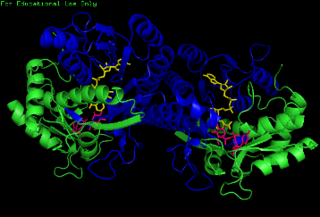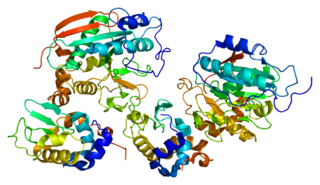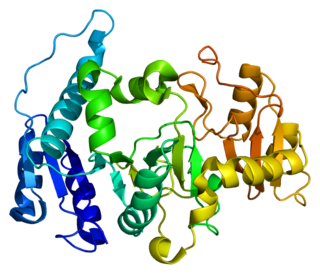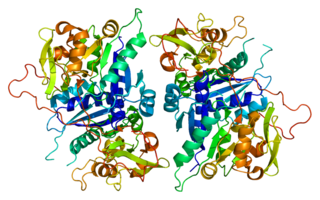
The enzyme UDP-glucose 4-epimerase, also known as UDP-galactose 4-epimerase or GALE, is a homodimeric epimerase found in bacterial, fungal, plant, and mammalian cells. This enzyme performs the final step in the Leloir pathway of galactose metabolism, catalyzing the reversible conversion of UDP-galactose to UDP-glucose. GALE tightly binds nicotinamide adenine dinucleotide (NAD+), a co-factor required for catalytic activity.

Beta-1,4-galactosyltransferase 1 is an enzyme that in humans is encoded by the B4GALT1 gene.

Carbohydrate sulfotransferase 6 is an enzyme that in humans is encoded by the CHST6 gene.

Alpha-(1,3)-fucosyltransferase is an enzyme that in humans is encoded by the FUT7 gene.

N-acetyllactosaminide beta-1,6-N-acetylglucosaminyl-transferase is an enzyme that in humans is encoded by the GCNT2 gene.

UDP-N-acetylglucosamine—dolichyl-phosphate N-acetylglucosaminephosphotransferase is an enzyme that in humans is encoded by the DPAGT1 gene.

Beta-1,4-mannosyl-glycoprotein 4-beta-N-acetylglucosaminyltransferase is an enzyme that in humans is encoded by the MGAT3 gene.

Alpha-1,6-mannosylglycoprotein 6-beta-N-acetylglucosaminyltransferase A is an enzyme that in humans is encoded by the MGAT5 gene.

Carbohydrate sulfotransferase 4 is an enzyme that in humans is encoded by the CHST4 gene.

CMP-N-acetylneuraminate-beta-galactosamide-alpha-2,3-sialyltransferase is an enzyme that in humans is encoded by the ST3GAL4 gene.

UDP-GlcNAc:betaGal beta-1,3-N-acetylglucosaminyltransferase 2 is an enzyme that in humans is encoded by the B3GNT2 gene.

UDP-GlcNAc:betaGal beta-1,3-N-acetylglucosaminyltransferase 3 is an enzyme that in humans is encoded by the B3GNT3 gene.

Alpha-1,3-mannosyl-glycoprotein 2-beta-N-acetylglucosaminyltransferase is an enzyme that in humans is encoded by the MGAT1 gene.

Beta-1,4-galactosyltransferase 2 is an enzyme that in humans is encoded by the B4GALT2 gene.

Beta-1,4-galactosyltransferase 5 is an enzyme that in humans is encoded by the B4GALT5 gene.

Carbohydrate sulfotransferase 5 is an enzyme that in humans is encoded by the CHST5 gene.

Galactosylgalactosylxylosylprotein 3-beta-glucuronosyltransferase 2 is an enzyme that in humans is encoded by the B3GAT2 gene.

Beta-1,4-galactosyltransferase 4 is an enzyme that in humans is encoded by the B4GALT4 gene.

Beta-1,4-galactosyltransferase 3 is an enzyme that in humans is encoded by the B4GALT3 gene.
O-linked glycosylation is the attachment of a sugar molecule to the oxygen atom of serine (Ser) or threonine (Thr) residues in a protein. O-glycosylation is a post-translational modification that occurs after the protein has been synthesised. In eukaryotes, it occurs in the endoplasmic reticulum, Golgi apparatus and occasionally in the cytoplasm; in prokaryotes, it occurs in the cytoplasm. Several different sugars can be added to the serine or threonine, and they affect the protein in different ways by changing protein stability and regulating protein activity. O-glycans, which are the sugars added to the serine or threonine, have numerous functions throughout the body, including trafficking of cells in the immune system, allowing recognition of foreign material, controlling cell metabolism and providing cartilage and tendon flexibility. Because of the many functions they have, changes in O-glycosylation are important in many diseases including cancer, diabetes and Alzheimer's. O-glycosylation occurs in all domains of life, including eukaryotes, archaea and a number of pathogenic bacteria including Burkholderia cenocepacia, Neisseria gonorrhoeae and Acinetobacter baumannii.


















